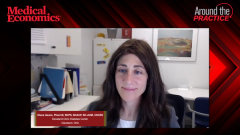
Overview of Diabetes and Cardiovascular Disease
Dhiren Patel, PharmD, CDE, BC-ADM, BCACP; Robert Busch, MD; and Muthiah Vaduganathan, MD, MPH, provide an overview of cardiovascular comorbidities in patients with diabetes.
Episodes in this series

Dhiren Patel, PharmD, CDE, BC-ADM, BCACP: Welcome to this Medical Economics Around the Practice Program titled “Management of Diabetes and Cardiovascular Comorbidities.” I’m Dr. Dhiren Patel, adjunct associate professor of Pharmacy Practice at the Massachusetts College of Pharmacy and Health Sciences in Boston, and an endocrine clinical pharmacy specialist.
Joining me in this discussion today are: Dr. Robert Busch, director of Clinical Research and a practicing endocrinologist at Albany Medical College in Albany, New York;
Dr. Muthiah Vaduganathan, a cardiologist at Brigham and Women’s Hospital and faculty at Harvard Medical School in Boston, Massachusetts;
And Dr. Dianna Isaacs, a clinical pharmacy specialist and the CGM Program Coordinator at the Cleveland Clinic Diabetes Center in Cleveland, Ohio. Thank you all for taking the time and joining us here today.
One thing that I wanted to get everyone’s initial reactions on is we know diabetes has been a very glucose-centric disease and we have been very hyper focused on blood sugars and A1Cs, but we now are moving to a time where the glycemic control is still emphasized and we don’t want to forget about it, but it’s increasingly becoming more about cardiovascular disease and some of these comorbidities that you’re seeing. You see that reflected in the guidelines, where it is no longer driven by A1C criteria or glycemic. So maybe, Dr. Busch, can you walk us through what you have seen here as we have gone from not just taking care of patients with diabetes, but we’re managing the patients as a whole and some of these comorbidities as it relates to diabetes.
Robert Busch, MD: It used to be walk into an exam room, you worried about micro and macrovascular disease, which you still worry about, but it was never felt that glycemic control would benefit macrovascular disease. If you wanted to lower heart attacks and strokes: Where is your statin? Where’s your ACE [angiotensin-converting enzyme] or ARB [angiotensin receptor blockers]? And that was standard of care. Go to the eye doctor once a year: Where is your statin? Is your LDL [low-density lipoprotein] at goal? Where is your ACE or ARB? Is your blood pressure at goal? Don’t give NSAIDs [non-steroidal anti-inflammatory drugs] or COX2s [cyclooxygenase-2] that can harm the kidneys, and look at the patient’s feet. But now, when we are utilizing our diabetes drugs, what other macrovascular benefit does the diabetes drug have? Fortunately, because rosiglitazone got beaten up by the FDA [Food and Drug Administration], it was mandated that every new diabetes drug had to do a cardiovascular safety trial. We never dreamt that a diabetes drug would have macrovascular benefit, and after seeing what the SGLT-2s [sodium-glucose cotransporter-2] and GLP-1s [glucagon-like peptide-1] did, now it’s a whole different field. Now, even our cardiologist we’ll have on board here, will be talking about diabetes management not from the diabetes standpoint, besides the statin, the ACE or ARB, maybe the icosapent if the triglycerides are high, what else can I do with your diabetes drug to lower MI/stroke and death.
Dhiren Patel, PharmD, CDE, BC-ADM, BCACP: Yeah. Actually, let us get the cardiology perspective. I know sometimes in our practice, they joke around with some of these drugs, especially as you see some of these drugs with heart failure indicates. They are like you found the glycemic benefits before we found the cardiac benefits, and these are actually cardiac drugs that happen to have some glycemic benefit. But would love the cardiology perspective here.
Muthiah Vaduganathan, MD, MPH: It has been an incredible decade of investigation and then new options for patients and continuing expanding roles of some of these drugs in various domains. These have become, I think more and more clinicians across specialties are becoming familiar, comfortable with prescribing them, continuing them, managing any adverse effects or practicalities of use, and so they are becoming almost household names. That, I think, is a definite benefit to multiple systems.
I think there is increasing recognition that patients are on too many drugs for too many conditions, and often it is helpful if individual drugs can target multiple disease domains. The SGLT-2 inhibitors and the GLP-1 receptor agonists do just that and can allow us to minimize use of some of our other therapies. For instance, antihypertensive therapies or diuretics in certain cases. That, I think, is quite beneficial.
The other aspect that is untold is that when we do have new therapies that target broader disease domains, there’s actually also increasing recognition for those conditions. We are screening earlier, for instance, for cardiovascular disease amongst patients with diabetes, and detecting them at an earlier stage where prevention can take place in this transition between primary and secondary prevention. So it’s a fascinating time and I think we’re making positive advances both in diagnosis and treatment of cardiovascular disease and cardiometabolic illness.
Dhiren Patel, PharmD, CDE, BC-ADM, BCACP: Yes, absolutely. I know we are talking about diabetes, but also as we progress through this segment, a lot of this impact is now we are seeing in patients that don’t have diabetes and you’re still seeing that benefit. One thing I want to just, while you have the mic, is ask a question regarding heart failure in patients with diabetes, but also without. I feel like now that we have additional tools in our toolbox, we are probably doing maybe a little bit of a better job. How are you seeing the management of heart failure? I know we are going to go into more details, but even just the prevalence among those patients with type 2 diabetes, and then, like I said, now that we don’t have these restrictions around those only with diabetes status, how do you see that changing?
Muthiah Vaduganathan, MD, MPH: Yeah. It is a great question. I think in terms of heart failure prevalence, in the United States there is about 6 million Americans with heart failure, and that’s a relatively small cohort compared with chronic kidney disease, diabetes. Yet, when we’re in the hospital or the clinic, it seems like we see a disproportionate number of heart failure patients. They do have a disproportionate health care utilization, hospitalization rate, and so their clinical impact on practices is large.
The estimates of the number of people with diabetes, who have concomitant heart failure, really do range based on the screening and how early we detect heart failure. But the SGLT-2 inhibitors have really revolutionized the care of heart failure with reduced EF [ejection fraction], which is now a condition that has almost become treatable in some sense. There are now multiple therapies that can not only extend life but extend meaningful life. Keep people out of the hospital. Keeping people feeling well, and nearly normalize some of the pathophysiological derangements of the disease process.
The bigger challenge that we have faced is now about implementing multiple drugs at once in some patients who, especially early on in their disease course, may feel well and otherwise not want to take multiple drugs for prevention of potential future events.
Transcript edited for clarity.
Newsletter
Stay informed and empowered with Medical Economics enewsletter, delivering expert insights, financial strategies, practice management tips and technology trends — tailored for today’s physicians.












